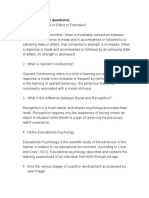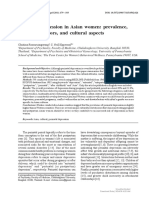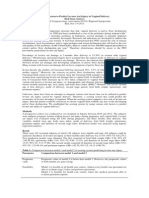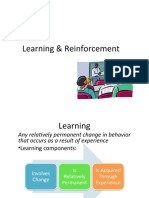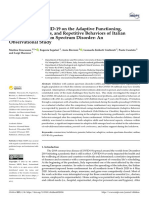0 ratings0% found this document useful (0 votes)
64 viewsIntimidation: A Tool of Learning? Do We Learn Better Under The Gun?
Intimidation: A Tool of Learning? Do We Learn Better Under The Gun?
Uploaded by
Budi Iman SantosoThis document discusses intimidation and bullying in medical education. It presents the results of a survey of 76 obstetrics and gynecology residents at a hospital in Indonesia. The survey found that 50% reported experiencing intimidation, primarily from other residents and consultants. While most residents do not think intimidation is an effective learning tool, 18.8% think it is unnecessary to have policies preventing intimidation. The document concludes that intimidation is a cycle that requires a multi-disciplinary policy approach to prevent its negative impacts on medical education.
Copyright:
© All Rights Reserved
Available Formats
Download as PPT, PDF, TXT or read online from Scribd
Intimidation: A Tool of Learning? Do We Learn Better Under The Gun?
Intimidation: A Tool of Learning? Do We Learn Better Under The Gun?
Uploaded by
Budi Iman Santoso0 ratings0% found this document useful (0 votes)
64 views39 pagesThis document discusses intimidation and bullying in medical education. It presents the results of a survey of 76 obstetrics and gynecology residents at a hospital in Indonesia. The survey found that 50% reported experiencing intimidation, primarily from other residents and consultants. While most residents do not think intimidation is an effective learning tool, 18.8% think it is unnecessary to have policies preventing intimidation. The document concludes that intimidation is a cycle that requires a multi-disciplinary policy approach to prevent its negative impacts on medical education.
Original Description:
intimidasi
Original Title
Intimidation
Copyright
© © All Rights Reserved
Available Formats
PPT, PDF, TXT or read online from Scribd
Share this document
Did you find this document useful?
Is this content inappropriate?
This document discusses intimidation and bullying in medical education. It presents the results of a survey of 76 obstetrics and gynecology residents at a hospital in Indonesia. The survey found that 50% reported experiencing intimidation, primarily from other residents and consultants. While most residents do not think intimidation is an effective learning tool, 18.8% think it is unnecessary to have policies preventing intimidation. The document concludes that intimidation is a cycle that requires a multi-disciplinary policy approach to prevent its negative impacts on medical education.
Copyright:
© All Rights Reserved
Available Formats
Download as PPT, PDF, TXT or read online from Scribd
Download as ppt, pdf, or txt
0 ratings0% found this document useful (0 votes)
64 views39 pagesIntimidation: A Tool of Learning? Do We Learn Better Under The Gun?
Intimidation: A Tool of Learning? Do We Learn Better Under The Gun?
Uploaded by
Budi Iman SantosoThis document discusses intimidation and bullying in medical education. It presents the results of a survey of 76 obstetrics and gynecology residents at a hospital in Indonesia. The survey found that 50% reported experiencing intimidation, primarily from other residents and consultants. While most residents do not think intimidation is an effective learning tool, 18.8% think it is unnecessary to have policies preventing intimidation. The document concludes that intimidation is a cycle that requires a multi-disciplinary policy approach to prevent its negative impacts on medical education.
Copyright:
© All Rights Reserved
Available Formats
Download as PPT, PDF, TXT or read online from Scribd
Download as ppt, pdf, or txt
You are on page 1of 39
INTIMIDATION: A TOOL OF LEARNING?
DO WE LEARN BETTER UNDER THE GUN?
REVEALING THE UGLY TRUTH AND THE NEED OF INTIMIDATION POLICY
Budi Iman Santoso, SpOG(K)
Departemen Obstetri dan Ginekologi FKUI / RSCM
OUTLINE
INTRODUCTION
DEFINITION , TYPE, SYMPTOM
INTIMIDATION IN MEDICAL EDUCATION
THE SURVEY
CONCLUSION
INTRODUCTION
INTIMIDATION is always an interesting problem at any level of education
or simply at any stage of life.
INTRODUCTION
At the beginning, everything was beautiful and exciting
Especially, when receiving the letter of acceptance to the residency
LATER, ITS ALL ABOUT THE ENDLESS
NIGHTMARES
Tight
schedule
Unfriendly
learning
atmosphere
Im nothing but 'a piece of s*** with a badge'.
Lowest
status in
hierarchy
TO SOME OTHERS IT MAY BE
NOTHING.
YOU LEARN BETTER UNDER
THE GUN !!!
Which is true?
THE GUN
INTIMIDATION , HARASSMENT ,
BULLYING
Have similar meaning:
to frighten, threat or hurt a weaker person
DEFINITION: INTIMIDATION, BULLYING,
HARASSMENT
University of New Jersey, Mistry & Latoo, Dan Olweus:
Is intended to cause harm or distress
Occurs repeatedly over time
Occurs in a relationship in which there is an imbalance of power or
strength
By definition, INTIMIDATION = NO GOOD
TYPE OF INTIMIDATION
SYMPTOMS
Table 2. Symptoms of intimidation
Physical Emotional
Sleeplessness Acute anxiety
Nausea Feeling isolated
Migraine/severe
headaches
Loss of confidence/self-
esteem
Palpitations Depression
Skin complaints Panic attacks
Sweating/shaking Anger
Backache Mood swings
Loss of appetite Lack of motivation
Lethargy Suicidal thoughts
INTIMIDATION AS LEARNING TOOL
IN MEDICAL EDUCATION
GOOD BAD
GOOD INTIMIDATION
Could be simply named as SUPERVISION
BAD INTIMIDATION
It is difficult to settle or even discuss problems in an
atmosphere of intimidation
(J.F.Kennedy, 35
th
President of US, 1917-1963)
INTIMIDATION IS A CYCLE
THE SURVEY
Research question: Is intimidation a good learning tool?
Subject: all residents at Department of Obstetri-
Gynecology, FMUI, Cipto Mangunkusumo Hospital
Site: Cipto Mangunkusumo Hospital, Jakarta, Indonesia
Period: End of November Early December 2011
Method:
Simple survey by questionnaire
A questionnaire consists of 3 parts
8 questions on demographic characteristic
Statement on definition of intimidation to prevent bias
15 questions on respondents opinion as bullies, bullied or
bystanders
RESULTS AND DISCUSSION
We are all either bullies, bullied or bystanders
(Richard L. Gross, MD American Academy of Child and adolescent psychiatry, 2011)
THE RESULTS
Demographic characteristics
Profile on the Bullied
The Bystanders ~ similar to the bullied
The Bullies
Opinions on intimidation as a learning tool
Opinions on the needs of policy to prevent
intimidation
DEMOGRAPHIC CHARACTERISTICS
Of all 85 residents at Department Ob-gyn FMUI,
76 (89%) participated in the study
44.7% male and 55.3% female
Range of age : mostly at 26-30 years, others 31-35 years
Marital status:
50% married, 48.3% single and 1.7% had divorced
94.1% were from State University; 5.9% of Private
University
81.5% had urban and 18.5% had rural childhood
PROFILE OF INTIMIDATION ON THE
BULLIED / VICTIM PERSPECTIVE
Yes
51.3%
No
48.8%
Being intimidated
PROFILE ON THE BULLIED / VICTIM
Once a month
66.7%
Less than once a month 16.7%
Once a week 13.9%
Every day 2.8%
PROFILE ON THE BULLIED / VICTIM
TYPE of intimidation
Words (70%), written (17.1%), gesture (17.1%)
Physical (23%), cyber-bullying (2.4%)
BULLIERS
Peer-residents (80.5%), Consultant s(46.3%)
Nurses (14.6%), Patients (12.2%)
IMPACT
Wasted time (85.9%), financial problem (34.1%)
No effect (28.8%), Health (14.9%)
Family (7.3%), study program (2.4%)
PROFILE ON THE BULLIED / VICTIM
How to deal with the stress:
Talk to others (39,0%)
Wish the situation would go away(36.6%)
Praying more (29.3%), positive thinking (24.4%)
Doing nothing (14.6%). more sleep (12.2%),
Eating more (9.8%), eating less(4.9%)
Smoking (4.9%)
Adequate supporters
Colleague (95.8%), others (24.4%), no one (9.8%),
Chief resident (12.2%), Head of Study Program(2.4%)
PROFILE OF INTIMIDATION ON THE
BULLIER PERSPECTIVE
No
91.7%
Yes
8.3%
PROFILE OF INTIMIDATION ON THE
BULLIER PERSPECTIVE
Less than
once a month
50%
At least once
a month
50%
PROFILE OF INTIMIDATION ON THE
BULLIER PERSPECTIVE
Profile of Bullier vs. Bullied
BEING INTIMIDATED
Bullied Not Bullied
INTIMIDATING
Bullier
100.0%
Non-Bullier
45.5%
54.5%
INTIMIDATION AS A LEARNING TOOL
Will you do intimidation
in the future?
93.0% NO
If intimidation continues
Disagree 58.2%
Try other specialty 11%
NO
60.9%
YES
13.0%
YES/NO
26.1%
THE NEED OF POLICY
Policy Maker
Head of Department - 47.7%
Head of Study Program - 35.4%
Dean - 18.5%
Head of University - 15.4%
Chief Resident - 12.3%
Minister of Health - 3.1%
Includes: Rewards and punishment
75% agree to punish bullier
94.0% disagree giving reward to
bullier
Necessary
81.2%
Unnecessary
18.8%
DISCUSSION
The survey has good response rate 89%
Cohen 51% response rate
Incidence of intimidation 50%
Similar to other studies
Ahmer 52%, medical students in Pakistan
Frank 40%, medical students in US
Scot 50%, junior residents in Auckland Hospital, New Zealand
Mostly who had been intimidated were male, had rural
childhood similar to study by Ahmer in Pakistan
No sexual harassment has been revealed
DISCUSSION
The majority of bullier were peer-residents and
consultant instead of being role-model
Similar to Ahmer and Frank
All of the bullier had prior experience of been
bullied (100%) indicating transgenerational legacy
Mostly disagree that intimidation is a learning tool
It is different from findings in Musselman study that
indicate the acceptable good intimidation
Different acceptance is affected by different assumption,
life background and interpretation
Further studies are necessary
DISCUSSION
If intimidation continues, 11.9% would consider to
quit and try other specialty
Frank 13% for other profession; Cohen - 14% for
other specialty and 22% for other profession
Policy to prevent intimidation was regarded as
necessary
BMA - Integrated in Strategic Health Care Alliance
National bullying hotline
Head of Department would be the best policy
maker (47.7%) and the least popular was Minister
of Health (3.1%)
CONCLUSION
Intimidation, harassment and bullying have similar
meaning to threat, to harm weaker person
Role of intimidation as learning tool in medical
education is still on debate.
Good intimidation is simply called SUPERVISION
CONCLUSION
Our survey indicates high incidence of intimidation
and bad impacts in Obs-gyn residents at
Department of Obstetri and Ginekologi FMUI
Cipto Mangunkusumo hospital
Policy to prevent intimidation is necessary
Intimidation is a cycle; therefore it should be
managed by multi-disciplinary experts
Those who can do; but those who cant bully
(Tim Field, British Anti-bullying Activist, 1952)
A man who is intimate with God is not intimidated by man
(Leonard Ravenhill, Christian Evangelist, Author, 1907-1994)
FIGHT BULLYING AND INTIMIDATION
BREAK YOUR FEAR
Once upon a time, there was a Korean Slave, who
did not dare to free herself
Even when a hero has come to set her free
The hero told her,
Youll be a SLAVE forever if you always think you are.
Freedom is earned, not given and it starts when youre
WILLING to free yourself
The words inspired her, her will had set her free
and
made her have a peaceful life
THANK YOU
You might also like
- Disability Support Pension Claim FormsDocument11 pagesDisability Support Pension Claim Formscurtisbrown89No ratings yet
- Learned Helplessness A Theory For The Age of Personal Control PDFDocument376 pagesLearned Helplessness A Theory For The Age of Personal Control PDFshimaa sedik100% (3)
- Cutting Understanding and Overcoming Self-Mutilation (Levenkron, Steven)Document244 pagesCutting Understanding and Overcoming Self-Mutilation (Levenkron, Steven)sisiner09 Dascălu100% (4)
- Ageism PowerpointDocument11 pagesAgeism Powerpointapi-254132646No ratings yet
- Marcel Case StudyDocument5 pagesMarcel Case StudyPrismatic Ray100% (1)
- Solution-Focused Family TherapyDocument15 pagesSolution-Focused Family Therapyltlmiss100% (8)
- Question Bank PDFDocument10 pagesQuestion Bank PDFLalramngaihawmiNo ratings yet
- Intercultural PsychotherapyDocument371 pagesIntercultural PsychotherapyHezron Barnabas100% (1)
- Learning ActiviDocument3 pagesLearning ActiviKarrel D. SyNo ratings yet
- Behavioral Science Aid For The USMLE Step 1 Behavioral Science Aid For The USMLE Step 1 (7905)Document4 pagesBehavioral Science Aid For The USMLE Step 1 Behavioral Science Aid For The USMLE Step 1 (7905)Aladdin Ali Abu DanielNo ratings yet
- Cellular AberrationDocument8 pagesCellular AberrationRaymund IdicaNo ratings yet
- Dissertation On Domestic Violence in PregnancyDocument4 pagesDissertation On Domestic Violence in PregnancyCustomWritingPapersKnoxville100% (1)
- Intimidation - AbstractDocument25 pagesIntimidation - AbstractBudi Iman SantosoNo ratings yet
- Suicide Among The YouthDocument21 pagesSuicide Among The YouthSahil MirNo ratings yet
- Kids and PTSDDocument56 pagesKids and PTSDcalista3lucille100% (1)
- Australian Indigenous Mental Health Screening & Assessment ToolsDocument68 pagesAustralian Indigenous Mental Health Screening & Assessment ToolsAmitNo ratings yet
- Adolescent Reproductive HealthDocument13 pagesAdolescent Reproductive HealthJohn Lester M. Dela CruzNo ratings yet
- Investigatory Infertility ProjectDocument16 pagesInvestigatory Infertility ProjectMahiNo ratings yet
- Overcoming Fear of Death: HapterDocument13 pagesOvercoming Fear of Death: HapterGustavoNo ratings yet
- Textbook of Psychological Medicine Fifth EditionDocument44 pagesTextbook of Psychological Medicine Fifth EditionalansparrowhawkNo ratings yet
- SuicidalDocument28 pagesSuicidaladrianaNo ratings yet
- GD-MAED-GC-A-Organization, Administration and Supervision of Guidance ServicesDocument20 pagesGD-MAED-GC-A-Organization, Administration and Supervision of Guidance ServicesGulodEsNo ratings yet
- Final Research PaperDocument11 pagesFinal Research Paperapi-313003825No ratings yet
- Malaysian Youth Mental Health and Well Being SurveyDocument9 pagesMalaysian Youth Mental Health and Well Being SurveyFelix YewNo ratings yet
- Tapos Na PaghihirapDocument41 pagesTapos Na Paghihirapharreh hotdoggssNo ratings yet
- Bully PDFDocument6 pagesBully PDFNSNo ratings yet
- Research ProposalDocument14 pagesResearch Proposalapi-284446774No ratings yet
- PHD Thesis SuicideDocument7 pagesPHD Thesis Suicidebk2j2x1a100% (1)
- Domestic Violence Awareness Month Series DocumentDocument4 pagesDomestic Violence Awareness Month Series DocumentKemoy FrancisNo ratings yet
- Assessment Two - HealthDocument5 pagesAssessment Two - Healthapi-359543029No ratings yet
- Teen SuicidesDocument19 pagesTeen SuicidesKUMAR SIMHADHRI HU21CSEN0101917No ratings yet
- Deppres Anx Selfconcept SYNOPSISDocument14 pagesDeppres Anx Selfconcept SYNOPSISignou helpNo ratings yet
- Week 2 - WHD Though Life StagesDocument51 pagesWeek 2 - WHD Though Life Stagesmemoona kaleemNo ratings yet
- 437572499-Biology-investigatory-project (1)Document25 pages437572499-Biology-investigatory-project (1)reshmathangam27No ratings yet
- Tourette's SyndromeDocument31 pagesTourette's SyndromeGhadeer AlomariNo ratings yet
- Future Directions For Client EducationDocument1 pageFuture Directions For Client EducationJerish Ann AgawinNo ratings yet
- Professional ResilienceDocument15 pagesProfessional ResilienceRob JosephNo ratings yet
- Introduction To Behavioral SciencesDocument45 pagesIntroduction To Behavioral ScienceseresdNo ratings yet
- Final IPDocument6 pagesFinal IP2024-nca-arch-355No ratings yet
- Effect of BullyingDocument11 pagesEffect of BullyingAnonymous 2ch6hSNo ratings yet
- Suicide August 2024Document41 pagesSuicide August 2024ruthharrymwale1No ratings yet
- Lecture#1 01-14-14 Why Is Nursing of Children Different?Document12 pagesLecture#1 01-14-14 Why Is Nursing of Children Different?nkuligowskiNo ratings yet
- Chapter 1Document7 pagesChapter 1Antonio Meneses Valdez100% (2)
- Young and Middle Adult, Older AdultDocument31 pagesYoung and Middle Adult, Older AdultGabz GabbyNo ratings yet
- Stuttering Course PDFDocument55 pagesStuttering Course PDFCarmela PappagalloNo ratings yet
- Fact Sheet Presentation: Microcephaly by T. GrassoDocument11 pagesFact Sheet Presentation: Microcephaly by T. GrassoTatimomNo ratings yet
- Chapter IDocument38 pagesChapter IKhristal ChaeNo ratings yet
- Engaging Multiple Personalities Volume 2: Therapeutic Guidelines: Engaging Multiple Personalities, #2From EverandEngaging Multiple Personalities Volume 2: Therapeutic Guidelines: Engaging Multiple Personalities, #2Rating: 5 out of 5 stars5/5 (1)
- Day 4 - Common Session 1 - Ped PC - DR Maryann MuckadenDocument82 pagesDay 4 - Common Session 1 - Ped PC - DR Maryann Muckadenm debNo ratings yet
- Dudova - Literature Review EssayDocument5 pagesDudova - Literature Review EssaySára DudováNo ratings yet
- Semester 1 - STRAND 2Document13 pagesSemester 1 - STRAND 2api-3699215No ratings yet
- JuredDocument10 pagesJuredANISA RIFKA RIDHONo ratings yet
- Gambaran Tingkat Pengetahuan Dan Sikap Wanita Tuna Susila Terhadap Infeksi Hiv/Aids Di Lokalisasi Kopeng Kabupaten SemarangDocument8 pagesGambaran Tingkat Pengetahuan Dan Sikap Wanita Tuna Susila Terhadap Infeksi Hiv/Aids Di Lokalisasi Kopeng Kabupaten SemarangMega Wati BaharNo ratings yet
- Trauma Informed Teaching 3 0Document56 pagesTrauma Informed Teaching 3 0api-380868644No ratings yet
- Antisocial Personality DisorderDocument44 pagesAntisocial Personality DisorderTaylor BauerNo ratings yet
- 53350-Article Text-84277-1-10-20100401Document3 pages53350-Article Text-84277-1-10-20100401Kenji CaldaNo ratings yet
- Suicidal Ideation and Social Support Among Freshmen Students: Basis For Intervention Program ImprovementDocument12 pagesSuicidal Ideation and Social Support Among Freshmen Students: Basis For Intervention Program ImprovementEzra BanateNo ratings yet
- RPRT Need To Be CorrectedDocument30 pagesRPRT Need To Be Correctedtalal rishadNo ratings yet
- (Asian Biomedicine) Perinatal Depression in Asian Women Prevalence Associated Factors and Cultural AspectsDocument15 pages(Asian Biomedicine) Perinatal Depression in Asian Women Prevalence Associated Factors and Cultural AspectsIntan Hajar FauzaninNo ratings yet
- 01women's Health Untuk KeperawatanDocument18 pages01women's Health Untuk Keperawatanriska assaNo ratings yet
- Thesis - EnglishDocument17 pagesThesis - EnglishKyle Cayaban100% (1)
- Presentation MCHConf Smith IdentificationOfChildrenAtRisk Apr2016 PDFDocument40 pagesPresentation MCHConf Smith IdentificationOfChildrenAtRisk Apr2016 PDFHamdan KopralNo ratings yet
- HLSC 1F90 November 28Document4 pagesHLSC 1F90 November 28Michael TruongNo ratings yet
- RECLAIM YOUR HEALTH - ALZHEIMER'S DISEASE: Learn how to overcome the most common chronic illnessesFrom EverandRECLAIM YOUR HEALTH - ALZHEIMER'S DISEASE: Learn how to overcome the most common chronic illnessesNo ratings yet
- Trauma-informed Care for Nursing Education Fostering a Caring Pedagogy, Resilience & Psychological SafetyFrom EverandTrauma-informed Care for Nursing Education Fostering a Caring Pedagogy, Resilience & Psychological SafetyNo ratings yet
- Slide Urogyn PracticeDocument7 pagesSlide Urogyn PracticeBudi Iman SantosoNo ratings yet
- Alkes ObGinDocument12 pagesAlkes ObGinBudi Iman SantosoNo ratings yet
- BISA Presentasi IUGA BaliDocument2 pagesBISA Presentasi IUGA BaliBudi Iman SantosoNo ratings yet
- Opportunities, Issues and Challenges in Indonesia OnDocument1 pageOpportunities, Issues and Challenges in Indonesia OnBudi Iman SantosoNo ratings yet
- IUGA Scoring SystemDocument40 pagesIUGA Scoring SystemBudi Iman SantosoNo ratings yet
- Slide StandarmedpracticeDocument32 pagesSlide StandarmedpracticeBudi Iman SantosoNo ratings yet
- Training Site Directory: Asia Europe Latin America OceaniaDocument47 pagesTraining Site Directory: Asia Europe Latin America OceaniaBudi Iman SantosoNo ratings yet
- Bali Program4Document5 pagesBali Program4Budi Iman SantosoNo ratings yet
- Completing The Continuous Improvement Plan: CIP Technical Assistance Document March 2005Document14 pagesCompleting The Continuous Improvement Plan: CIP Technical Assistance Document March 2005Budi Iman SantosoNo ratings yet
- VSC Services in IndonesiaDocument10 pagesVSC Services in IndonesiaBudi Iman SantosoNo ratings yet
- Form Urodinamik YPKDocument3 pagesForm Urodinamik YPKBudi Iman SantosoNo ratings yet
- EvidenceDocument28 pagesEvidenceBudi Iman SantosoNo ratings yet
- Coaching Agenda Development ToolDocument2 pagesCoaching Agenda Development ToolBudi Iman SantosoNo ratings yet
- Adly Nanda A: DR - DR Budi Iman Santoso, Spog (K)Document44 pagesAdly Nanda A: DR - DR Budi Iman Santoso, Spog (K)Budi Iman SantosoNo ratings yet
- Urinary Incontinence As A Worldwide ProblemDocument12 pagesUrinary Incontinence As A Worldwide ProblemBudi Iman SantosoNo ratings yet
- Application FormDocument14 pagesApplication FormBudi Iman SantosoNo ratings yet
- The Pathophysiology and Etiology of VaginismusDocument6 pagesThe Pathophysiology and Etiology of VaginismusBudi Iman SantosoNo ratings yet
- Theories of MotivationDocument3 pagesTheories of MotivationDates TreeNo ratings yet
- Beyond Positive Psychology. Toward A Contextual View of Psychological Processes and Well Being PDFDocument18 pagesBeyond Positive Psychology. Toward A Contextual View of Psychological Processes and Well Being PDFÓscar Ignacio Giraldo RoldánNo ratings yet
- An Introduction To The Types of SchizophreniaDocument4 pagesAn Introduction To The Types of Schizophreniasarzlasco09No ratings yet
- Focus Diagnosis Action ResponseDocument2 pagesFocus Diagnosis Action ResponseGrape JuiceNo ratings yet
- Module 6Document1 pageModule 6Dodong Tomada89% (9)
- Adhd 2Document6 pagesAdhd 2api-259262734No ratings yet
- Joyce L. Knight: Steward/CookDocument3 pagesJoyce L. Knight: Steward/CookJoyce KnightNo ratings yet
- Beck PDFDocument1 pageBeck PDFWulan Purwanty100% (2)
- Confidential: Mental Health Treatment PlanDocument2 pagesConfidential: Mental Health Treatment PlanRoseNo ratings yet
- Developmental BiologyDocument4 pagesDevelopmental BiologyBobbyNo ratings yet
- L5 ReinforcementDocument16 pagesL5 ReinforcementRudraksh PareyNo ratings yet
- Gestalt Therapy: Frederick S. PerlsDocument15 pagesGestalt Therapy: Frederick S. PerlsGrethel Pagcaliwangan100% (1)
- Obsessive-Compulsive Disorder (OCD) : Resources and ReferencesDocument20 pagesObsessive-Compulsive Disorder (OCD) : Resources and ReferencesAddy Louis CordovaNo ratings yet
- Behavior TherapyDocument50 pagesBehavior TherapyRoberto VargasNo ratings yet
- Clinical Instruction On Projective Techniques in The USA: A Review of Academic Training Settings 1995-2014Document11 pagesClinical Instruction On Projective Techniques in The USA: A Review of Academic Training Settings 1995-2014Ana Luisa VargasNo ratings yet
- A Plea For Affirmation Relating To States of Unmentalised AffectsDocument10 pagesA Plea For Affirmation Relating To States of Unmentalised AffectsDaniel Andres Racines JervesNo ratings yet
- CBT17 - Exposure and Response Prevention - Fall 2020Document211 pagesCBT17 - Exposure and Response Prevention - Fall 2020Natalia Ramirez100% (1)
- Art TherapyDocument4 pagesArt TherapyCharise LigoresNo ratings yet
- Children 08 00096 v2Document14 pagesChildren 08 00096 v2Aimen MurtazaNo ratings yet
- Physiobiologic Bases and Behavior Neuroscience: Biology and BehaviorDocument25 pagesPhysiobiologic Bases and Behavior Neuroscience: Biology and BehaviorKeith AquinoNo ratings yet
- 10 - Cognitive TherapyDocument32 pages10 - Cognitive Therapymartinjeanell100% (1)
- Ass 1 401Document3 pagesAss 1 401Mahnoor FatimaNo ratings yet
- Presentation, Analysis and Interpretation of DataDocument25 pagesPresentation, Analysis and Interpretation of Datakylle orlandaNo ratings yet
- Master of Social Work Counselling (MSW (C) Second Year) : Assignment: 2021-2022Document7 pagesMaster of Social Work Counselling (MSW (C) Second Year) : Assignment: 2021-2022Aakif SalamNo ratings yet
- Mary - Binet Kamat ITDocument5 pagesMary - Binet Kamat ITEva97doe100% (3)






